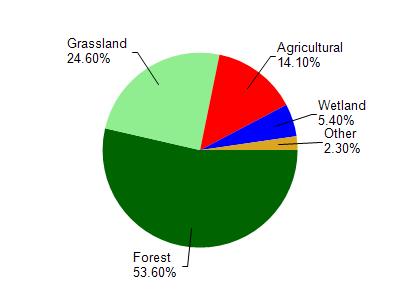Iowa
No
No
No
Fish and Aquatic Life
Overview
Snead Creek is a tributary to Rush Creek. The creek supports a cold water forage fish
population. A rare aquatic species has been found in the creek. Intensive cattle grazing along
the stream has exposed streambanks, resulting in severe erosion. The water is turbid and the
stream has been widened by this activity. In-stream habitat has also probably been affected
by the agricultural practices along the stream. The stream has been ponded and these ponds
make the stream's fishery unmanageable.
From: Ripp, Coreen, Koperski, Cindy and Folstad, Jason. 2002. The State of the Lower Wisconsin River Basin. PUBL WT-559-2002. Wisconsin Department of Natural Resources, Madison, WI.
Date 2002
Author Cynthia Koperski
Historical Description
Snead Creek is a tributary to Rush Creek. Intensive cattle grazing along the stream have
exposed streambanks, resulting in examples of severe erosion. The water is turbid and
the stream appears widened (WDNR, 1991). In-stream habitat has probably been
affected by the agricultural practices along the stream.
Date 1994
Author Surface Water Inventory Of Wisconsin
Historical Description
Sneed Creek - Mouth location T8N R3E Section 28 -2, Surface area = 2.6 acres, Length = 4.3 miles, Gradient = 28.3 feet per mile, Total alkalinity = 244.0 mg/l, Volume of flow = 2.1 cfs.
Sneed Creek is a spring fed tributary of Rush Creek. It has one spring fed tributary of its own which contributes about 30 percent of the base flow. Although its gradient is not extremely high the cleared character of its watershed is reflected in flooding and severe bank erosion which are especially common to the lower sections.
The construction of a flood control structure was once contemplated but this failed to materialize. There are at least two farm ponds on the upper reaches which utilize springs for their water supplies and provide some angling. However, the stream is considered questionable for trout and too small for smallmouth bass. Rainbow trout fingerlings were stocked in 1963 but their survival has not been determined. There is a sizable forage fish population consisting of bigmouth shiners, spot fin shiners, johnny darters, fantail darters, fathead minnows and brook sticklebacks. Aquatic game is limited to some muskrats found throughout its length. There are no public lands on this stream but it is accessible from three road crossings.
From: Piening, Ronald and Threinen, C.W., 1968. Lake and Stream Classification Project. Surface Water Resources of Iowa County, Wisconsin Department of Natural Resources, Madison, WI.
Date 1968
Author Surface Water Inventory Of Wisconsin
Condition
Wisconsin has over 84,000 miles of streams, 15,000 lakes and milllions of acres of wetlands. Assessing the condition of this vast amount of water is challenging. The state's water monitoring program uses a media-based, cross-program approach to analyze water condition. An updated monitoring strategy (2015-2020) is now available. Compliance with Clean Water Act fishable, swimmable standards are located in the Executive Summary of Water Condition in 2018. See also the 'monitoring and projects' tab.
Management Goals
Wisconsin's Water Quality Standards provide qualitative and quantitative goals for waters that are protective of Fishable, Swimmable conditions [Learn more]. Waters that do not meet water quality standards are considered impaired and restoration actions are planned and carried out until the water is once again fishable and swimmable
Management goals can include creation or implementation of a Total Maximum Daily Load analysis, a Nine Key Element Plan, or other restoration work, education and outreach and more. If specific recommendations exist for this water, they will be displayed below online.
Monitoring
Monitoring the condition of a river, stream, or lake includes gathering physical, chemical, biological, and habitat data. Comprehensive studies often gather all these parameters in great detail, while lighter assessment events will involve sampling physical, chemical and biological data such as macroinvertebrates. Aquatic macroinvertebrates and fish communities integrate watershed or catchment condition, providing great insight into overall ecosystem health. Chemical and habitat parameters tell researchers more about human induced problems including contaminated runoff, point source dischargers, or habitat issues that foster or limit the potential of aquatic communities to thrive in a given area. Wisconsin's Water Monitoring Strategy was recenty updated.
Grants and Management Projects
| Project Name (Click for Details) | Year Started |
|---|
|
|
Monitoring Projects
| WBIC | Official Waterbody Name | Station ID | Station Name | Earliest Fieldwork Date | Latest Fieldwork Date | View Station | View Data |
|---|
| 1240000 | Sneed Creek | 10039457 | Snead Creek at Lake View Rd | | | Map | Data |
| 1240000 | Sneed Creek | 10044784 | Sneed Creek at High Point Rd | 7/9/2015 | 7/20/2015 | Map | Data |
| 1240000 | Sneed Creek | 10028737 | Sneed Creek At County Road C | | | Map | Data |
|

Watershed Characteristics
Sneed Creek is located in the Otter and Morrey Creeks watershed which is 198.69 mi². Land use in the watershed is primarily forest (53.60%), grassland (24.60%) and a mix of agricultural (14.10%) and other uses (7.70%). This watershed has 437.57 stream miles, 351.55 lake acres and 5,785.74 wetland acres.
Nonpoint Source Characteristics
This watershed is ranked Not Ranked for runoff impacts on streams, Low for runoff impacts on lakes and High for runoff impacts on groundwater and therefore has an overall rank of High. This value can be used in ranking the watershed or individual waterbodies for grant funding under state and county programs.However, all waters are affected by diffuse pollutant sources regardless of initial water quality. Applications for specific runoff projects under state or county grant programs may be pursued. For more information, go to surface water program grants.